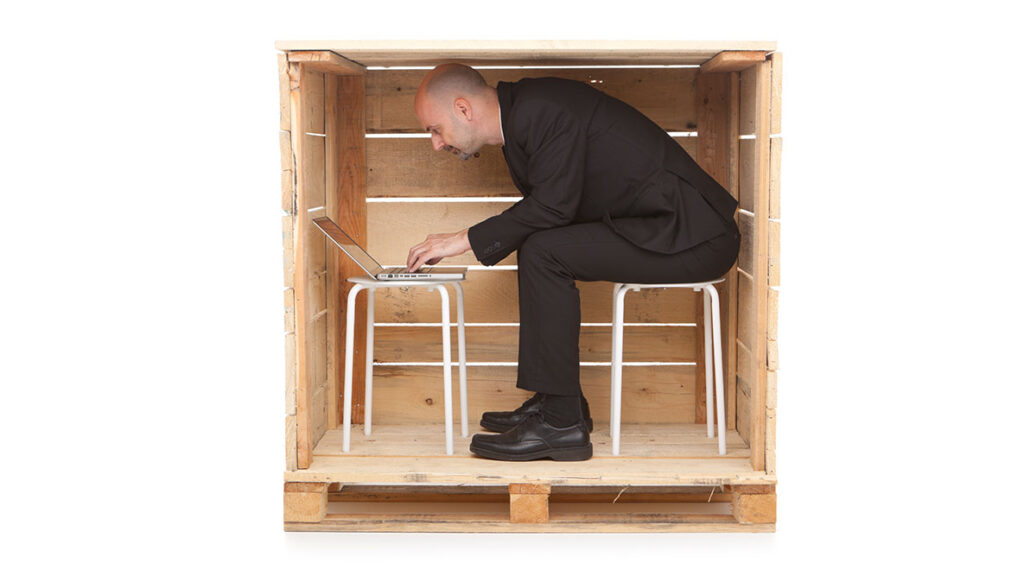Trapped in a box of our own making
How “free” tools are costing you more than you expect.

In 1964 a Welsh teenager who had recently emigrated to Australia became homesick and determined to return home.1 Unfortunately, Brian Robson had spent most of his money on the journey there and hadn’t been working long enough in Australia to afford the trip back.
Robson hatched a plan to have some friends nail him into a 30” x 26” x 38” wooden box and ship him back to Wales. In the crate, Robson had everything he thought he’d need for the journey: his suitcase, a flashlight, a bottle of water, an empty bottle for urine, and a small hammer to let himself out of the crate in London.
After the first couple of hours, Robson – who was sitting with his knees curled up to his chest – began to cramp. He also found himself in an unpressurized cargo plane with very little oxygen for the first leg of his trip. When he arrived in Sydney 90 minutes later for his connecting flight, Robson was unloaded onto the tarmac upside down. He spent the next 22 hours in the heat of the sun sitting on his neck and head.
Robson had arranged for himself to be shipped direct from Sydney to London, but that plane was full. He wound up on a Pan Am flight to Los Angeles. Five days later, Robson was in enormous pain and fading in and out of consciousness. He lost his sense of time and direction and at one point thought he would surely die.
That’s when two airline employees saw his flashlight shining through the cracks in his crate and opened it up, shocked to see a person in the cargo. Robson spent six days in the hospital recovering from the ordeal and Pan Am paid for him to fly back home in first class. Recently, when asked about the experience, Robson said, “It’s a part of my life that in all honesty I’d like to forget, but in all practicality I could never forget.”
Putting yourself in a box
While Brian Robson regretted his low-tech, low-cost solution almost immediately, the dangerous box that many companies nail themselves into isn’t as quickly or obviously painful. So, they endure the pain and the unseen costs that come from using paper, spreadsheets, and file management systems to facilitate critical processes.
The protocols companies develop to do everything from maintain equipment, to order supplies, and invoice customers should, in theory, help them operate safely and efficiently. But protocols are only as good as our ability to follow them. It’s tough to measure the effectiveness of processes if you don’t know who was trained on them or who is actually using them. It’s even harder to enforce them when the process of closing the loop takes hours or days.
Imagine if you picked three frontline operators randomly and asked them to show you the correct way to perform a critical procedure. Would you get three separate outcomes? Would any of the operators know where to find and follow the procedure? Would they all take the proper safety precautions?
We’ve helped customers break out of the box and take real control of their processes. What they gain goes beyond efficiency. Some find their processes aren’t working as well as they thought. They’re paying for it too. Rework, customer quality complaints, unpaid invoices, team member retention problems – these are the real costs.
From upside down on the tarmac to a first-class ticket home
Despite our best intentions, we can find ourselves in a spot that we never intended. Here are a couple of real-world examples of companies who used the wrong tools and found themselves in untenable situations.
- EHS processes that protect your organization’s team members can also be some of the most complicated to implement and track. Depending on the industry, regulations and protocols can vary drastically from location to location. When accidents happen or new regulations are passed, the speed at which you can implement new protocols can be a matter of life and death.
An Acadia customer manufactures durable goods globally with the support of a 2,000-person safety team. The safety leadership team invested heavily in developing protocols but not in a system to manage, distribute, and report on their adoption.
With a framework including a traditional document repository, spreadsheets, and printed documents, managing the system required excessive people hours. The safety leadership team, for example, would spend three months per year auditing each manufacturing facility in person.
After converting to Acadia, the safety team has eliminated two months of manual work from their annual review process. Updates to policies, in response to an incident, can be distributed across the enterprise immediately, instead of after several hours or days. Leadership knows when each employee has seen and acknowledged the new protocol, instead of waiting for the annual audit.
- The process for distributing SOPs to the workforce in a warehouse/distribution center was arduous. It took an average of 614 hours to process all that paper! And paper was their biggest obstacle to efficiency and compliance. SOPs were produced and distributed to staff on paper. Managers recorded which employees received the SOPs on paper. Then the results of those reports were manually entered into an electronic system to ensure all employees received the correct documents. Even with all that effort, the company couldn’t tell if employees were following the SOPs, and team members couldn’t provide feedback to improve the procedures.
After converting their paper procedures to digital documents in Acadia, things were a lot easier. Any new or updated SOPs could be delivered to the relevant employees with a few clicks. The system itself could identify when all employees had received them. Managers also have the ability to audit employees for compliance and provide additional training to those who need it.
In less than six months, the company blew by their target goal for distributing SOPs, reducing their process change training time by 90%!
- Prior to deploying Acadia, our customer had separate systems for creating, managing and tracking SOPs at each of its global facilities. In many cases, the SOPs were deployed on paper, making it difficult to track adoption and compliance.
Now, as nearly all facilities have converted to Acadia, paper is being eliminated. Acadia provides job aids to team members as they complete their daily tasks and enables them to provide feedback on process improvements. It also helps managers see which team members are following One Best Way procedures and which ones need more training support.
As more locations come on board, the customer sees advantages beyond the line efficiency improvements at individual locations. They easily share best practices across all locations, making their global continuous improvement program even more powerful.
If you’re boxing yourself in using outdated tools to run your mission critical protocols, you run the risk of doing serious damage. By managing your processes with a purpose-built platform, you’ll pass audits, shed costs, and keep your teams safe.
Read on:
The simple training tool you’re probably not using

Cement process knowledge and change behavior…
Sources:
"*" indicates required fields
Ready to crush your goals?
"*" indicates required fields